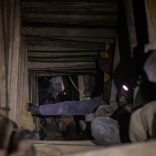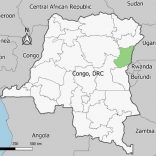How a US mission to push a Trump deal in Congo unravelled
When South Africa sneezes SADC catches the cold

The Citizen / People's March on Friday
Recent events in South Africa where President Jacob Zuma unexpectedly wielded the axe on former Minister of Finance Pravin Godhan and eight more of his counterparts resulting the rand plummeting in value by two percent have reignited debate on the sustainability of the region depending on that country for economic solace.
Last week, the South African rand, a major trading currency in the SADC region, took a two percent knock on the back of Zuma’s cabinet reshuffle which is now known as “Zuma’s night of long knives”.
Moreover the manoeuvres in South Africa have also raised debate on whether it is sustainable for countries like Namibia to sustain pegging their currency (the Namibian dollar) at one-on-one to the rand bearing the adverse effects of poor decision making on anything down south.
It has also brought into question whether countries like Zimbabwe should adopt the rand as their currency. While the rand has been one of the currencies in the basket of foreign currencies introduced in Zimbabwe in 2009, together with the United States dollar, to ease that country’s economic challenges, there have been recent calls for the country to go full throttle and adopt the rand following an acute shortage of the greenback.
Ironically, South Africa is the largest economy in the region and also has the second largest Gross Domestic Product (GDP) on the African continent after Nigeria. That dominance of the South African economy in regional affairs has seen it taking the lion’s share of the Southern African Customs Union dividends and also remain the leader in industrial growth.
The unfolding political events in South Africa confirm the belief that when South Africa sneezes the whole of the Southern African Development Community catches the cold because of the dominance of the South African rand and their economy in the region.
The decision by Zuma saw the South African rand going on a freefall from trading at R12.24 to the green back to trading at R$13.53 within hours of the cabinet reshuffle.
The South African economy by far the largest and competitive in the Southern African region is the biggest exporter to countries like Namibia Swaziland, Botswana, and Lesotho which make up SACU, the world’s oldest customs union.
In fact, Namibia imports 65 percent of her consumables from South Africa and relies on that economy for supply of necessities because of a long absence of a manufacturing industry since independence in 1990.
South Africa is also the largest trading partner to Zimbabwe and most of their companies have penetrated the whole region, making that country the industry of the region.
Although the Bank of Namibia Governhas in the past vehemently dismissed any thoughts of delinking the South African rand and the Namibian dollar before the debate is still very much alive in his country, analysts feel political decisions made in South Africa have had detrimental effects on the Namibian economy.
“Imports from South Africa are presently less expensive than they might if the Namibian dollar is delinked. The fact that about 65 percent of goods consumed in Namibia are imported from South Africa implies that Namibia would incur transaction cost in the process,” Shiimi told a local weekly last week while commenting on the issue of delinking the rand.
Worse still the Namibian, Botswana, Lesotho and Swaziland economies have remained largely consumptive economies that rely heavily on the South African economy for imports of consumables and basic communities while circulation of the rand in these countries is very strong.
However, a renowned economic analyst in Namibia Klaus Schade, writing in one of his columns published in The South Times titled “To delink or not to delink” said debate of such nature is recurrent in Namibia and the region bearing in mind the interrelatedness and interdependence of the economies.
“There have been calls recently from some commentators to re-consider the one-to-one peg of the Namibia dollar to the South African rand because of the rand’s strong depreciation over the past year. It is interesting to note that these calls are usually made when the rand is under pressure, not when it is appreciating against major currencies.
“Before evaluating the merits of such calls, a brief review of the rand’s performance vis-à-vis major currencies such as the US dollar and some emerging market currencies such as the currencies of the BRIC countries (Brazil, Russia, India, China) is necessary,” he said.
He added, “These monetary policy responses indicate that the appreciation or depreciation of a currency is not ‘good’ or ‘bad’ per se. The depreciation of a currency is a monetary tool to among others gain competitive advantages since domestic goods and services become less expensive not only on the international market but also on the domestic market compared to goods and services from countries whose currencies appreciated.
“The depreciation of a currency is therefore being used as an industrial policy instrument. The flip side of the coin is, however, that imports become more expensive, including imports that are used in the production of exportable goods.
“In countries with a narrow industrial base, such as Namibia, that rely on the importation of most consumer goods and coupled with an arid climate dependant on the importation of most of the foodstuff, increasing import prices can finally lower the population’s standard of living unless they are compensated for the rising costs of living by increasing salaries, wages and or social transfers.”
What S&P downgrading mean for SA
According to the chief strategist at Citadel & Cannon Asset Managers and also Visiting Professor at Gordon Institute of Business Science, Adrian Saville, the ratings downgrades are a clear sign to policymakers, investors, business and society in general that the economy is not on track.
Although S&P announced its decision to downgrade South Africa’s ratings soon after President Zuma’s Cabinet reshuffle, analysts believe the decision to do so was already in the offing.
They argue that South African government bond yields have been priced similarly to the likes of Brazil and Russia for the best part of the year and based on economic growth projections alone, SA has been failing S & P’s acid test for investment grade status for sometime.
However, the irony of all this justifies President Zuma’s sacking of Pravin Gordhan as he had been in charge as the ominous downgrading was being contemplated given the fact that the SA bond yields were being priced the same as Brazil and Russia for the better part of the year.
As remedies to regain investment grade status, Professor Saville suggests the need for high private sector savings rates fuelling high domestic investment levels. The second is sound monetary policy that is effective in managing the risk of consumer price inflation running away during the recovery period.
By Tiri Masawi













Leave a Reply
Be the First to Comment!
You must be logged in to post a comment.
You must be logged in to post a comment.